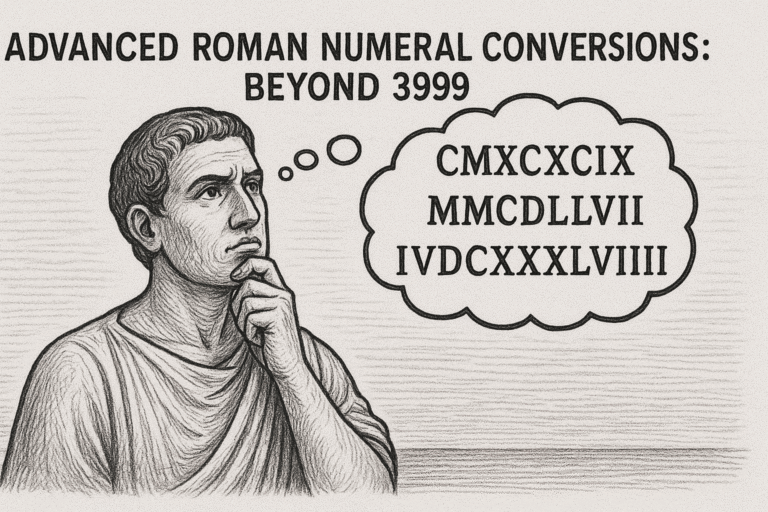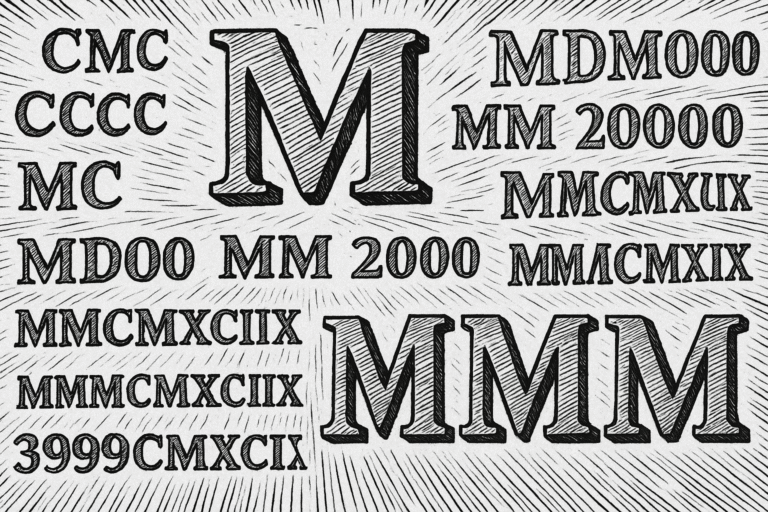When Did the Roman Empire Fall? A Detailed Exploration of Its Decline

The fall of the Roman Empire is one of history’s most debated and complex events, marking the end of an era that shaped Western civilization. Roman numerals, used extensively in Roman records, inscriptions, and timelines, help us pinpoint and understand key dates in this transformative period. But when exactly did the Roman Empire fall, and what factors contributed to its decline?
This article delves into the timeline of the Roman Empire’s collapse, the role of Roman numerals in documenting it, and the historical context surrounding this pivotal moment. Ideal for students, historians, or anyone curious about ancient Rome, this guide provides a comprehensive look at the empire’s end.
Understanding the Roman Empire’s Scope
Before exploring its fall, let’s define the Roman Empire. Originating from the city of Rome, traditionally founded in CCLIII (753 BCE), the empire grew to encompass the Mediterranean, Europe, North Africa, and parts of the Middle East. At its peak under Emperor Trajan (XCVIII–CXVII, or 98–117 CE), it was a powerhouse of culture, engineering, and governance.
The empire is often divided into two phases:
- Western Roman Empire: Centered in Rome, covering Western Europe and North Africa.
- Eastern Roman Empire: Later known as the Byzantine Empire, centered in Constantinople.
The “fall” typically refers to the collapse of the Western Roman Empire, as the Eastern Empire persisted for centuries. Roman numerals, used in inscriptions, coins, and documents, are key to dating these events accurately.
When Did the Western Roman Empire Fall?
The fall of the Western Roman Empire is most commonly dated to CDLXXVI (476 CE), when the last emperor, Romulus Augustulus, was deposed. However, this event was not a sudden collapse but the culmination of a long decline. Below, we explore this date, alternative perspectives, and the role of Roman numerals in documenting the timeline.
The Traditional Date: 476 CE (CDLXXVI)
In CDLXXVI (476 CE), the Germanic chieftain Odoacer deposed Romulus Augustulus, the last Western Roman emperor. This event is widely accepted as the symbolic end of the Western Roman Empire because:
- It marked the end of Roman imperial rule in the West.
- Odoacer declared himself King of Italy, bypassing the imperial title and sending the regalia to Constantinople, acknowledging the Eastern emperor’s authority.
Roman numerals appear in historical records of this event, such as inscriptions or chronicles, where CDLXXVI denotes the year. For example, contemporary documents might record “Annus CDLXXVI” to mark the deposition.
Alternative Dates for the Fall
The fall of the Roman Empire was a gradual process, and historians propose other key dates as potential endpoints:
- CCXLVIII (248 CE): The empire’s millennium celebration, after which internal crises intensified.
- CCCLXXXV (395 CE): The death of Emperor Theodosius I, the last to rule a unified empire, leading to the permanent division into East and West.
- CCCCX (410 CE): The sack of Rome by the Visigoths, a symbolic blow to Roman prestige.
- CCCCLV (455 CE): The sack of Rome by the Vandals, further weakening the West.
Each date reflects a significant milestone in the empire’s decline, and Roman numerals in chronicles (e.g., CCCCX for 410 CE) help historians pinpoint these moments.
The Eastern Roman Empire’s Continuity
While the West fell in CDLXXVI (476 CE), the Eastern Roman Empire, or Byzantine Empire, continued until MCDLIII (1453 CE), when Constantinople fell to the Ottoman Turks. Roman numerals were less common in Byzantine records, which adopted Greek influences, but they still appeared in early inscriptions, such as DXXXVII (537 CE) for the completion of the Hagia Sophia.
Factors Contributing to the Fall
The collapse of the Western Roman Empire resulted from a combination of internal weaknesses and external pressures. Below, we outline the key factors, with Roman numerals highlighting relevant dates.
1. Political Instability and Weak Leadership
The Western Empire suffered from frequent changes in leadership, with emperors often ruling briefly due to assassinations or coups. For example:
- Between CCXXXV (235 CE) and CCLXXXIV (284 CE), known as the Crisis of the Third Century, the empire saw over 20 emperors.
- Weak emperors like Romulus Augustulus (CDLXXV–CDLXXVI, 475–476 CE) lacked the authority to stabilize the empire.
Roman numerals in imperial decrees and coins (e.g., CCLXVIII for Emperor Claudius Gothicus’ reign in 268 CE) document this turbulent period.
2. Economic Decline
Economic challenges, including inflation and reliance on slave labor, weakened the empire:
- Heavy taxation to fund military campaigns strained the economy, recorded in ledgers using numerals like M (1,000) denarii.
- Devaluation of currency, such as in CCLXX (270 CE) under Emperor Aurelian, disrupted trade.
Numeral-based records helped track these financial struggles, though the system’s limitations hindered complex calculations.
3. Military Overextension
The empire’s vast size made it difficult to defend:
- By CC (200 CE), the empire stretched from Britain to Mesopotamia, requiring massive resources.
- In CCCCIX (409 CE), Germanic tribes crossed the Rhine, overwhelming defenses.
Military records, marked with numerals like L (50) for legions or C (100) for cohorts, show the scale of Rome’s military commitments.
4. Barbarian Invasions
External pressures from Germanic tribes and others accelerated the collapse:
- The Visigoths sacked Rome in CCCCX (410 CE).
- The Vandals followed in CCCCLV (455 CE).
- Odoacer’s deposition of Romulus Augustulus in CDLXXVI (476 CE) was the final blow.
Inscriptions on captured Roman artifacts often used numerals to mark these events, preserving their historical significance.
5. Social and Cultural Shifts
Internal divisions, including the rise of Christianity and declining civic loyalty, weakened Roman unity:
- In CCCXXXVII (337 CE), Emperor Constantine’s death marked Christianity’s growing influence, shifting focus from traditional Roman values.
- Urban decay and population decline, noted in census records with numerals like D (500), reduced the empire’s resilience.
Role of Roman Numerals in Documenting the Fall
Roman numerals were critical in recording the empire’s decline:
- Chronicles and Annals: Historians like Ammianus Marcellinus used numerals to date events, such as CCCLXIII (363 CE) for Emperor Julian’s death.
- Inscriptions: Triumphal arches and tombstones bore numerals, like CDX (410 CE) for the Visigoth sack.
- Coins: Emperors minted coins with numerals to mark regnal years (e.g., X for a 10-year reign).
- Administrative Records: Tax and military documents used numerals to quantify resources, such as MMM (3,000) soldiers.
These numeral-based records provide modern historians with precise timelines to reconstruct the empire’s fall.
Examples of Key Events with Roman Numerals
To illustrate, here are pivotal events with their Roman numeral dates:
- CCLIII (753 BCE): Traditional founding of Rome.
- CCXLVIII (248 CE): Rome’s millennium celebration, signaling early decline.
- CCCLXXXV (395 CE): Division of the empire under Theodosius I.
- CCCCX (410 CE): Visigoth sack of Rome.
- CDLXXVI (476 CE): Deposition of Romulus Augustulus.
These dates, preserved in Roman numeral form, anchor our understanding of the empire’s timeline.
Why the Fall Matters Today
The fall of the Roman Empire is more than a historical event; it offers lessons for modern societies:
- Political Stability: The dangers of weak leadership and division resonate in contemporary governance.
- Economic Management: Rome’s economic troubles highlight the importance of sustainable policies.
- Cultural Legacy: Roman law, architecture, and numerals continue to influence modern culture, seen in book chapters (I, II, III) or movie credits (MMXXV for 2025).
Understanding the fall through Roman numerals connects us to this legacy, making history tangible.
Common Misconceptions About the Fall
- Sudden Collapse: The empire didn’t fall overnight; CDLXXVI (476 CE) was a symbolic endpoint after centuries of decline.
- Barbarian Destruction: While invasions were significant, internal weaknesses were equally critical.
- Complete End: The Eastern Empire continued until MCDLIII (1453 CE), preserving Roman traditions.
Tips for Studying the Roman Empire’s Fall
- Learn Roman Numerals: Master the system to read dates like CDLXXVI accurately.
- Explore Primary Sources: Read chronicles or inscriptions, often marked with numerals, for firsthand accounts.
- Visit Historical Sites: Structures like the Colosseum, with numeral-inscribed gates, bring history to life.
- Use Conversion Tools: Online tools can help translate dates (e.g., 476 = CDLXXVI).
- Contextualize Events: Understand the broader social, economic, and military factors behind each date.
Conclusion
The fall of the Western Roman Empire, traditionally dated to CDLXXVI (476 CE), was a complex process driven by political instability, economic decline, military overextension, and external invasions. Roman numerals played a vital role in documenting this decline, appearing in inscriptions, coins, and records that preserve the empire’s timeline. By studying these numerals and the events they mark, we gain insight into one of history’s most transformative periods. Whether you’re a student decoding dates like CCCCX (410 CE) or an enthusiast exploring Roman ruins, understanding the fall of the Roman Empire enriches our connection to the past. Dive into this history, practice converting key dates, and appreciate the enduring legacy of Roman numerals in telling this monumental story.





